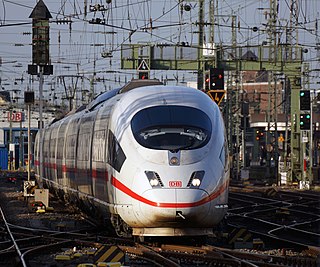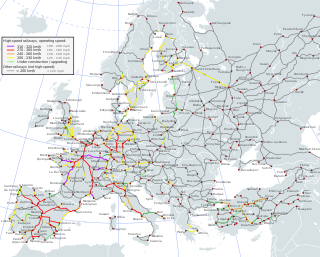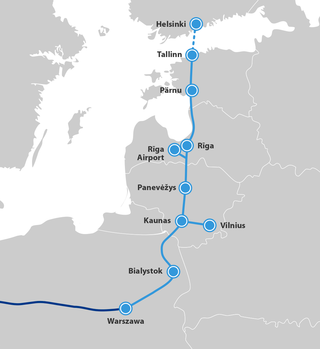Related Research Articles

Transport in Ghana is accomplished by road, rail, air and water. Ghana's transportation and communications networks are centered in the southern regions, especially the areas in which gold, cocoa, and timber are produced. The northern and central areas are connected through a major road system.
The Trans-European road network (TERN) was defined by Council Decision 93/629/EEC of 29 October 1993, and is a project to improve the internal road infrastructure of the European Union (EU). The TERN project is one of several Trans-European Transport Networks.

As of 2021, Germany had a railway network of 33,399 kilometres (20,753 mi), of which 20,540 kilometres (12,760 mi) were electrified and 18,556 kilometres (11,530 mi) were double track. Germany is a member of the International Union of Railways (UIC). The UIC Country Code for Germany is 80.

Transport in Europe provides for the movement needs of over 700 million people and associated freight.
The Trans-European Networks (TEN) were created by the European Union by Articles 154–156 of the Treaty of Rome (1957), with the stated goals of the creation of an internal market and the reinforcement of economic and social cohesion. To various supporters of this policy, it made little sense to talk of a big EU market, with freedom of movement within it for goods, persons and services, unless the various regions and national networks making up that market were properly linked by modern and efficient infrastructure. The construction of Trans-European Networks was also seen as an important element for economic growth and the creation of employment.

The Trans-European Transport Network (TEN-T) is a planned network of roads, railways, airports and water infrastructure in the European Union. The TEN-T network is part of a wider system of Trans-European Networks (TENs), including a telecommunications network (eTEN) and a proposed energy network. The European Commission adopted the first action plans on trans-European networks in 1990.

The modern terms short-sea shipping, marine highway and motorways of the sea, as well as the more historical terms coastal trade, coastal shipping, coasting trade and coastwise trade, all encompass the movement of cargo and passengers mainly by sea along a coast, without crossing an ocean.

Rail freight transport is the use of railways and trains to transport cargo as opposed to human passengers.
The European Rail Traffic Management System (ERTMS) is the system of standards for management and interoperation of signalling for railways by the European Union (EU). It is conducted by the European Union Agency for Railways (ERA) and is the organisational umbrella for the separately managed parts of

The Trans-European high-speed rail network (TEN-R), together with the Trans-European conventional rail network, make up the Trans-European Rail network, which in turn is one of a number of the European Union's Trans-European transport networks (TEN-T). It was defined by the Council Directive 96/48/EC of 23 July 1996.

Transport in the European Union is a shared competence of the Union and its member states. The European Commission includes a Commissioner for Transport, currently Adina Ioana Vălean. Since 2012, the commission also includes a Directorate-General for Mobility and Transport which develops EU policies in the transport sector and manages funding for Trans-European Networks and technological development and innovation, worth €850 million yearly for the period 2000–2006.
Motorways of the Sea is a concept in the transport policy of the European Union, stressing the importance of sea transport. The main aim of these Motorways of the Sea is to improve port communications with peripheral regions of the European continent and thus strengthen the networks between the EU candidate countries and those countries already part of the European Union.

Rail Baltica is an under-construction rail infrastructure project that is intended to integrate the Baltic states in the European rail network. Its purpose is to provide passenger and freight service between participating countries and improve rail connections between Central and Northern Europe, specifically the area southeast of the Baltic Sea. It is also intended as a catalyst for building the economic corridor in Northeastern Europe. The project envisages a continuous rail link from Tallinn (Estonia) to Warsaw (Poland), consisting of links via Riga (Latvia), Kaunas, and Vilnius (Lithuania). Its total length in the Baltic States is 870 kilometres (540 mi), with 213 kilometres (132 mi) in Estonia, 265 kilometres (165 mi) in Latvia, and 392 kilometres (244 mi) in Lithuania. Rail Baltica is one of the priority projects of the European Union (EU). It is part of the North Sea–Baltic Corridor of the Trans-European Transport Networks (TEN-T).
The Trans-European conventional rail network, together with the Trans-European high-speed rail network, make up the Trans-European Rail network, which in turn is one of a number of the European Union's Trans-European transport networks (TEN-T). It was defined by the Council Directive 2001/16/EC of 19 March 2001.
The Trans-European Inland Waterway network is one of a number of the Trans-European Transport Networks (TEN-T) of the European Union.
The Trans-European Seaport network is one of a number of the Trans-European Transport Networks (TEN-T) of the European Union.
The Trans-European Airport network is one of a number of the Trans-European Transport Networks (TEN-T) of the European Union.
The Trans-European Combined Transport network is one of a number of the Trans-European Transport Networks (TEN-T) of the European Union.
The Single European Railway Directive 2012 is an EU Directive that regulates railway networks in European Union law. This recast the First Railway Directive" and consolidates legislation from each of the first to the fourth "Package" from 1991 to 2016, and allows open access operations on railway lines by companies other than those that own the rail infrastructure. The legislation was extended by further directives to include cross border transit of freight.

Ministry of Transport and Communications is a government institution in the Republic of Lithuania which coordinates the work of road, rail, air, water, transport, postal and electronic communications sector and implements the strategy and politics of state government.